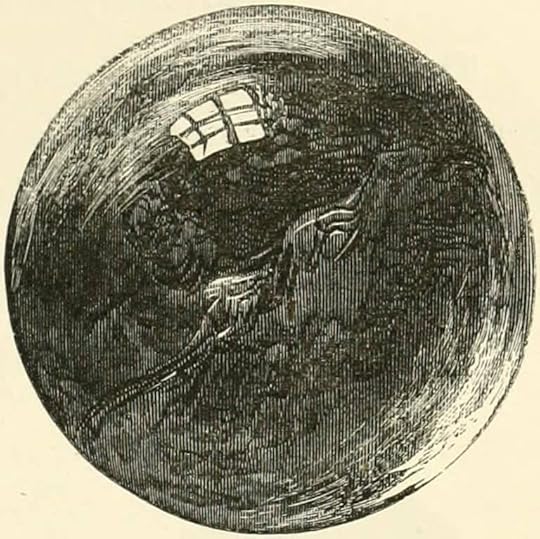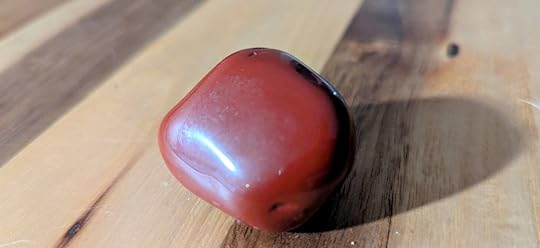The Charmstone of Clan Donnachaidh
My clan has a magic stone. It’s called the Clach na Bratach in Scots gaelic, meaning the Stone of the Standard. It was allegedly discovered in 1314 by Duncan the Stout (Donnchadh Reamhar), the founding chief of the Robertson Clan (Clan Donnachaidh). In this article, I begin by telling you its story, before explaining why I don’t believe in magic but, in a paradoxical sense, I do still believe in magic stones.
 Late 19th century woodcut of the Clach na Bratach.
Late 19th century woodcut of the Clach na Bratach.First, let’s discuss how the stone was discovered. The clan warriors were en route to Bannockburn, to fight under Robert the Bruce, when they made camp for the night, and struck their battle standard into the ground beside a nearby fountain. The following morning, as the standard was being pulled up, a clod of earth was dislodged, exposing a mysterious object that was spotted glinting among the dirt and gravel. The chief, mesmerized by this curious artefact, announced that it was a good omen, predicting victory and, sure enough, they were victorious in battle.
 Recent photograph of the stone from the Clan Donnachaidh Museum.
Recent photograph of the stone from the Clan Donnachaidh Museum.Seven centuries after its legendary discovery, the stone is now exhibited in the Clan Donnachaidh Museum in Pitlochry. It is a polished crystal ball, about the size of an apple. The clan’s warriors reputedly carried it into battle in a small metal cage atop their standard. In addition to bringing luck, and foretelling the outcome of battles, the Clan Donnachaidh subsequently claimed the stone had healing properties. It became the most celebrated charmstone or “Curing Stone’ in the history of Scotland.
We’re told that it cured all manner of diseases in cattle and horses, and up to a point, also in humans. They would drink the water in which the stone had been “thrice dipped” by the hands of the clan chief. Eventually, in 1715, a crack appeared in the stone just before Chief Alexander Robertson joined the doomed Jacobite rising. The chief was exiled, and the clan’s estates were forfeited, confirming the bad omen.
The stone was, nevertheless, still in use in the late 18th century, according to the text of a Memorandum by Duncan Robertson of Strowan.
There is a kind of stone in the family of Strowan which has been carry'd in their pockets by all their representatives time out of mind. […] They ascribe to this Stone the Virtue of curing Diseases in Men and Beasts, especially Diseases whose causes and symptoms are not easily discover'd; and many of the present Generation in Perthshire would think it very strange to hear the thing disputed.
The author is uncertain whether he believes in its healing powers or not:
The Wits and Philosophers laugh at the notion of ascribing such Virtues to a Stone, as a thing impossible and ridiculous. I wou'd not positively affirm that it has such Virtues as are ascribed to it, but I think I may safely say there is nothing impossible in it.
He explains that “hundreds in former ages, and many alive at this day, affirm that this Stone has been the means of curing some Diseases”. By the end of the 18th century, its perceived benefits were probably linked by many to the Christian faith.
There is a Prayer to be used at dipping the stone; and such Prayers if used with a Heart full of faith and Confidence in the Divine Goodness, wou'd undoubtedly prevail in every Distress, especially where ordinary means are wanting […]
This, of course, leads to an obvious question. After praying over this stone and drinking the water in which it had been dipped, did hundreds of my ancestors in the Clan Donnachaidh, over the centuries, recover from various “diseases whose causes are not easily discovered”, because of the power of suggestion?
 The Abbot of Inchaffray blesses the Scots before the Battle of Bannockburn
The Abbot of Inchaffray blesses the Scots before the Battle of BannockburnStoicism: Philosophy as a Way of Life is a reader-supported publication. To receive new posts and support my work, consider becoming a free or paid subscriber.
My Philosophy of CharmstonesI carry around a magic stone. Sometimes it sits on my desk when I’m working. Sometimes I handle it while walking and thinking about what it symbolizes. I walked into my local witchcraft shop recently and asked the friendly assistant for a stone that symbolizes anger. She recommended a piece of red jasper. I asked my wife to pick the best one out of the basket for me. I do not believe that stones have magic properties. Nevertheless, whenever I look at this one, I recall that it was specifically chosen because of its connection with anger. Whether that association exists in any natural or supernatural sense doesn’t matter to me, because it’s forever the memory that I have established about how it came into my possession. I purposefully created the association in my own mind.
 My own personal charmstone.
My own personal charmstone.I’m fascinated by the Clach na Bratach. Not because I actually believe it has magical powers but because I know that, for over five centuries, many hundreds of my clansfolk believed that it did, and that it cured their illnesses. (I’m not so sure how it could have cured their cows and horses, but that’s another matter.) When I look at it, it reminds me of the tremendous potential of the human mind, and I find that quite inspiring.
…we know enough about the power of suggestion to expect that roughly a third to half of them likely exhibited some symptom improvement as a result.
Perhaps not all of the sick people who came to the stone for help were actually cured of their diseases, although I’m confident that for a time, at least, they probably felt as if they were getting better. Moreover, we know enough about the power of suggestion to expect that roughly a third to half of them likely exhibited some symptom improvement as a result. That’s what we find, on average, from countless randomized controlled trials (RCTs) which include placebo control groups. So I believe that there are probably psychological benefits that can be obtained by treating charmstones as a form of autosuggestion. Nevertheless, it may surprise you to learn that’s not the main reason why I use them.
One of the most important psychological mechanisms in modern evidence-based psychotherapy is known as “cognitive distancing” or “cognitive defusion”. We have to use jargon to refer to it because although in some ways it’s a simple concept, it’s also an unfamiliar one to the majority of people, and so no word existed for it in the English language. Cognitive distancing was described by Aaron T. Beck, the founder of cognitive therapy, in his seminal treatment manual, Cognitive Therapy and the Emotional Disorders (1976). Suppose, Beck would say, that you have been wearing coloured spectacles, red ones, for so long that you’ve forgotten about them and now assume that the world is, in fact, reddish. The colour of the lenses becomes totally fused with your perception of external objects.
Now let’s say that you remove the glasses and suddenly realize that the redness resided in the lenses not the external objects. Beck said that cognitive distancing refers to the realization that, in a similar way, our thoughts colour our perception of the world. What if instead of red lenses, for instance, we had been wearing catastrophe-tinted ones, which make everything seem like a disaster, and cause us to feel highly anxious. Depressed people view the world through negativity-tinted glasses; anxious people view the world through threat-tinted glasses; and angry people view the world through hostility-tinted glasses. These are the biases that shape our perception of events, which other people may view quite differently, and often in a more neutral or indifferent way. We introduce distance between our thoughts and external events, by separating them from one another and realizing that we have been projecting our own upsetting ideas onto the world.
What does this have to do with magic stones? Well, there are actually half a dozen or more ways of helping people gain cognitive distance that therapists have discovered. One is to imagine that you are observing your thoughts and feelings from a more detached perspective, as if they are objects before your mind. Looking at the coloured glasses, in our metaphor, rather than looking through them. I can do that in various ways but one simple method is to imagine holding something symbolizing your troubling thought or belief in your hand, so that you can view it from different perspectives. You could just write the thought on a piece of paper and do this, although I like to imagine, for instance, that by holding my “anger stone”, I am observing various beliefs and attitudes associated with anger.
I find this very helpful as a psychological tool. It allows me to ponder the nature of anger, and how it affects us, with greater patience and curiosity. It seems to make it easier for me to spot things. Sometimes by lying on the floor of a room you may notice things about the decor that you’d previously overlooked. Shifting perspective can be a surprisingly powerful way of achieving an aha! moment, and noticing things that had previously gone unnoticed. When we’re dealing with our beliefs and emotions it can often lead to important new insights. Indeed, by looking at the Clach na Bratach from a different angle, I was able to gain an appreciation for charmstones, and find a novel way of using them in daily life.
I think we can all learn more about the nature of emotions by accepting them and patiently studying them from a detached perspective.
For instance, I might imagine that the rigid belief that people must listen to me, or do what I want — a common cause of anger — is in the palm of my hand. This allows me to roll it around, toss it in the air and catch it, and so on. I am able to experience the belief rather than struggling against it and trying to suppress or avoid it. I am also viewing it from a little bit of a distance rather than allowing myself to become too absorbed in it. I don’t ruminate about it, but just look at it and feel it in my hands, as symbolized by an object that I can pick up or put down, whenever I choose to do so. This not only allows me to practice detachment and objectivity toward troubling beliefs, it also gives me a different perspective on them. You might think I’d be wise to throw my anger stone away, and imagine I’m doing the same with my anger, but I think we can all learn more about the nature of emotions by accepting them and patiently studying them from a detached perspective.
When we view our own beliefs, and actions, from the outside, we tend to naturally find that we can see the pros and cons of holding them more clearly, we understand their consequences, and we can imagine replacing them with alternative beliefs. That gives us a chance to develop what psychologists call cognitive flexibility, as opposed to rigidity. We’re more able to see beyond our beliefs when we can view them from a distance as if they’re “over there” before us, rather than holding them so close that we identify with them completely. That’s why we find it easier to solve other people’s problems, in many cases, than to solve our own. We have biases and blind spots, which impair our judgment. One way of getting around these, is to place our beliefs in front of us, as if they’re exhibits in a museum, which we can look at from various different perspectives. In other words, choosing a stone to symbolize your anger, and the rigid demands associated with it, is just a convenient way of tricking the mind to gain cognitive distance.
Thanks for reading Stoicism: Philosophy as a Way of Life! This post is public so feel free to share it.



